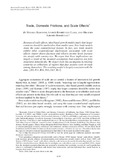Mostrar el registro sencillo del ítem
Trade, Domestic Frictions, and Scale Effects
| dc.contributor.author | Ramondo, Natalia | |
| dc.contributor.author | Rodríguez-Clare, Andrés | |
| dc.contributor.author | Saborío-Rodríguez, Milagro | |
| dc.date.accessioned | 2020-08-27T21:17:15Z | |
| dc.date.available | 2020-08-27T21:17:15Z | |
| dc.date.issued | 2016-10 | |
| dc.identifier.uri | http://dx.doi.org/10.1257/aer.20141449 | |
| dc.identifier.uri | https://repositorio.catie.ac.cr/handle/11554/9537 | |
| dc.description.abstract | Because of scale effects, idea-based growth models imply that larger countries should be much richer than smaller ones. New trade models share the same counterfactual feature. In fact, new trade models exhibit other counterfactual implications associated with scale effects: import shares decrease and relative income levels increase too steeply with country size. We argue that these implications are largely a result of the standard assumption that countries are fully integrated domestically. We depart from this assumption by treating countries as collections of regions that face positive costs to trade among themselves. The resulting model is largely consistent with the data. | es_ES |
| dc.language.iso | en | es_ES |
| dc.relation.ispartof | American Economic Review, Volumen 106, Number 10 (Octubre 2016) pages 3159–3184 | es_ES |
| dc.rights | info:eu-repo/semantics/openAccess | es_ES |
| dc.subject | ECONOMÍA | es_ES |
| dc.subject | COMERCIO | es_ES |
| dc.subject | CRECIMIENTO | es_ES |
| dc.subject | PRODUCTIVIDAD | es_ES |
| dc.subject | ANALISIS DE COSTOS | es_ES |
| dc.subject | GEOGRAFIA ECONOMICA | es_ES |
| dc.subject | INNOVACIONES | es_ES |
| dc.subject | COMERCIO INTERIOR | es_ES |
| dc.subject | EFECTOS | es_ES |
| dc.subject | TECNOLOGIA | es_ES |
| dc.title | Trade, Domestic Frictions, and Scale Effects | es_ES |
| dc.type | Artículo | es_ES |
Ficheros en el ítem
Este ítem aparece en la(s) siguiente(s) colección(ones)
-
Publicaciones y documentos [3628]


